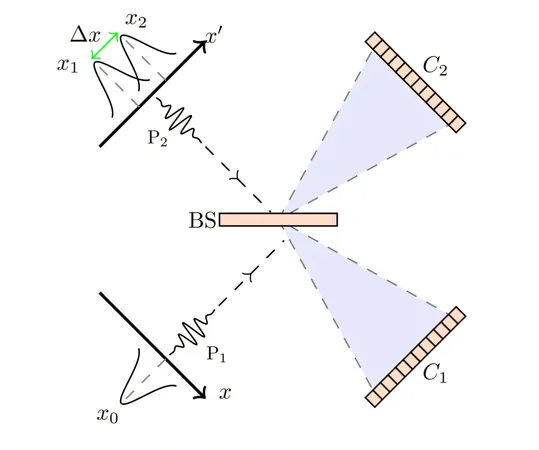
Uncovering the Secrets of the Past: Blue Rings in Trees and Shrubs Indicate Cold Summers Linked to Volcanic Eruptions
2025-01-22
Author: Noah
Introduction
A fascinating discovery has emerged from the icy landscapes of northern Norway, where scientists have identified mysterious blue rings in trees and shrubs that reveal chilling secrets of past summers. These peculiar blue rings form when trees experience insufficient warm days during their growth seasons, resulting in incomplete lignification of new growth. This unique phenomenon provides valuable insights into historical climate conditions.
Climate Data from Trees and Shrubs
Scientists have discovered that trees and shrubs can often live for centuries, making them perfect time capsules for climate data. By examining Scots pine trees and common juniper shrubs, researchers pinpointed two notably cold summers in 1902 and 1877, which they suspect may have been triggered by volcanic eruptions from Mount Pelée in Martinique and Cotopaxi in Ecuador, respectively.
The Findings of Dr. Agata Buchwal
Dr. Agata Buchwal from Adam Mickiewicz University in Poland, the lead author of a study published in Frontiers in Plant Science, explained, "These blue rings appear as unfinished growth rings and signify cold conditions during the growing season." Interestingly, the research indicated that blue rings were more prevalent in trees than in shrubs, suggesting that shrubs are better adapted to cope with cooling events. Dr. Buchwal enthusiastically noted, "Shrubs are the true heroes of the north."
Methodology of the Research
In their research, the scientists extracted core samples from 25 Scots pine trees and stem-base disks from 54 common juniper shrubs at the Mount Iškoras treeline. Using advanced microscopic techniques, they meticulously measured growth-ring widths and identified blue rings. Surprisingly, only 2.1% of the pine rings and 1.3% of the juniper rings displayed this distinctive coloration.
Patterns of Blue Rings
The results revealed a striking pattern: blue rings were most prevalent in 1902, appearing in 96% of pine trees and 68% of juniper shrubs, and again in 1877, with 84% and 36%, respectively. This suggests that pine trees are more sensitive to cold summer conditions compared to their juniper counterparts.
Impact on Trees
Dr. Pawel Matulewski, a co-author of the study, noted the implications of blue rings in boreal pine trees, mentioning that they could weaken the trees, making them more vulnerable to diseases or structural damage. "If this phenomenon persists over years, it may hinder recovery," he cautioned.
Connection to Weather Records
The researchers connected their findings to local weather records, pointing out that the summers of 1902 and 1877 were notably cool. In particular, June 1902 marked the coldest on record, significantly disrupting the growing season. The trees had sufficient time for earlywood growth, but latewood development faltered, explaining the surge of blue latewood cells—a striking indicator of adverse climate.
Timing of Cooling Events
A closer examination showed that the timing of cooling events may differ, with June 1902 impacting early growth and the late August cooling in 1877 potentially leading to more lignified, less blue rings.
Broader Climatic Changes
Moreover, blue rings have been linked to broader climatic changes, particularly following volcanic eruptions. The scientists suggest that the significant cold in June 1902 may correlate with the eruption of Mount Pelée, while the eruption of Cotopaxi in late June might connect to the subsequent cold in August 1877.
Need for Further Research
Despite these discoveries, the researchers stress the need for more comprehensive data. Some potential cold summer periods identified showed less severe cooling, and gaps in temperature records hindered deeper analysis. They also highlighted the variability in temperature readings at the Mount Iškoras weather station compared to conditions experienced by the trees, indicating a need for more localized weather data in future studies.
Conclusion
This compelling research not only unravels past climatic events but also emphasizes how nature's records can reveal a multitude of environmental stories, linking the power of volcanic eruptions to the delicate balance of our ecosystems. What other secrets might the trees hold? Scientists are eager to delve deeper into this intriguing world.









 Brasil (PT)
Brasil (PT)
 Canada (EN)
Canada (EN)
 Chile (ES)
Chile (ES)
 Česko (CS)
Česko (CS)
 대한민국 (KO)
대한민국 (KO)
 España (ES)
España (ES)
 France (FR)
France (FR)
 Hong Kong (EN)
Hong Kong (EN)
 Italia (IT)
Italia (IT)
 日本 (JA)
日本 (JA)
 Magyarország (HU)
Magyarország (HU)
 Norge (NO)
Norge (NO)
 Polska (PL)
Polska (PL)
 Schweiz (DE)
Schweiz (DE)
 Singapore (EN)
Singapore (EN)
 Sverige (SV)
Sverige (SV)
 Suomi (FI)
Suomi (FI)
 Türkiye (TR)
Türkiye (TR)
 الإمارات العربية المتحدة (AR)
الإمارات العربية المتحدة (AR)